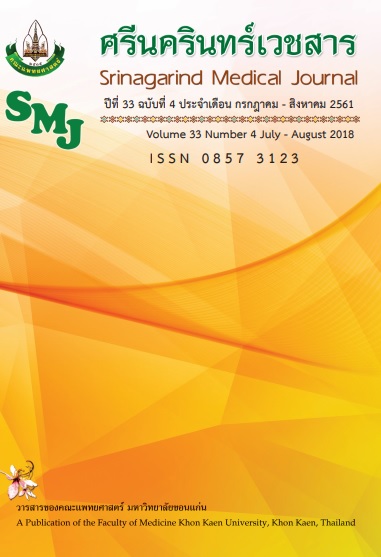The Effect of Dual Task on Lower Limb Joint Kinematics during Obstacle Crossing in Young and Healthy Older Adults
Keywords:
Lower limb joint kinematics; Dual task; Older adultsAbstract
Background and objective: The purpose of this study was to investigate the effects of dual task with different secondary tasks on trail limb joint kinematics during obstacle crossing in young and healthy older adults
Methods: 32 young adults and 32 healthy older adults participated in this study. They were instructed to walk crossing obstacle under 3 conditions; while performing an obstacle crossing task (single task) and a further 2 obstacle crossing tasks in randomized order; while holding a glass of water and while calculating backward by 3 steps. The Kinect camera using with MFU gait analysis software recorded trail limb angular displacement of the hip, knee and ankle joint. A two-way repeated ANOVA was used to determine the main interaction effect between group and condition effects on trail limb kinematics.
Results: The results showed no main interaction for group x condition interaction for trail limb joint kinematics.
Conclusions: The obstacle crossing while performing a dual task with different secondary tasks was found to affect of trail limb joint kinematics with no different between young adults and healthy older adults.
References
2. Namkhum S, Watcharasaksilp K, Sungkarat S. Comparisons of gait characteristics during obstacle crossing at different heights between older adults with and without mild cognitive impairment. Bull Chiang Mai Assoc Med Sci 2015; 48: 204-13.
3. Galna B, Peters A, Murphy AT, Morris ME. Obstacle crossing deficits in older adults: a systematic review. Gait Posture 2009; 30: 270-5.
4. Leisman G, Moustafa AA, Shafir T. Thinking, Walking, Talking: Integratory Motor and Cognitive Brain Function. Front Public Health 2016; 4: 94.
5. Leone C, Feys P, Moumdjian L, D'Amico E, Zappia M, Patti F. Cognitive-motor dual-task interference: A systematic review of neural correlates. Neurosci Biobehav Rev 2017; 75: 348-60.
6. Beurskens R, Steinberg F, Antoniewicz F, Wolff W, Granacher U. Neural Correlates of Dual-Task Walking: Effects of Cognitive versus Motor Interference in Young Adults. Neural Plast 2016; 2016: 8032180.
7. Asai T, Misu S, Doi T, Yamada M, Ando H. Effects of dual-tasking on control of trunk movement during gait: respective effect of manual- and cognitive-task. Gait Posture 2014; 39: 54-9.
8. Plummer-D’Amato P, Shea G, Dowd C. Motor versus cognitive dualtask effects on obstacle negotiation in older adults. Int J Ther Rehabil 2012; 19: 200-7.
9. Pizzamiglio S, Naeem U, Abdalla H, Turner DL. Neural Correlates of Single- and Dual-Task Walking in the Real World. Front Human Neurosci 2017; 11: 460.
10. Soma M, Masuda T, Shimamura R, Abiko T, Uematu H, Kawama K. Influence of a Dual-Task on Toe Clearance of the Young and Elderly While Stepping Over an Obstacle. J Phys Ther Sci 2010; 22: 75.
11. Meetam T, Charoensittisup P, Panmontha A, Sae-Lee W. Foot clearance distance and joint kinematics during stepping over an obstacle in high heeled gait. Thai Journal of Physical Therapy 2015; 37: 126-34.
12. Bonnechere B, Jansen B, Salvia P, Bouzahouene H, Omelina L, Moiseev F, et al. Validity and reliability of the Kinect within functional assessment activities: comparison with standard stereophotogrammetry. Gait Posture 2014; 39: 593-8.
13. Bohannon RW, Bubela DJ, Magasi SR, Wang YC, Gershon RC. Sit-to-stand test: Performance and determinants across the age-span. Isokinet Exerc Sci 2010; 18: 235-40.
14. Middleton A, Fritz SL. Assessment of gait, balance, and mobility in older adults: Considerations for Clinicians. Curr Transl Geriatr and Exp Gerontol 2013; 2: 205-14.
15. Schulz BW, Lloyd JD, Lee Iii WE. The effects of everyday concurrent tasks on overground minimum toe clearance and gait parameters. Gait Posture 2010; 32: 18-22.
16. LaRoche DP, Greenleaf BL, Croce RV, McGaughy JA. Interaction of age, cognitive function, and gait performance in 50–80-year-olds. Age (Dordr) 2014; 36: 9693.
17. Strobach T, Torsten S. Mechanisms of Practice-Related Reductions of Dual-Task Interference with Simple Tasks: Data and Theory. Adv Cogn Psychol 2017; 13: 28-41.
18. Shin S, Demura S, Watanabe T, Yabumoto T, Shi B, Sakakibara N, et al. Age-related and obstacle height-related differences in movements while stepping over obstacles. J Physiol Anthropol 2015; 34: 15.
19. Park SY, Lee YS. Kinematics of the lower limbs during obstacle crossings performed by young adults and the elderly. J Phys Ther Sci 2012; 24: 941-4.




